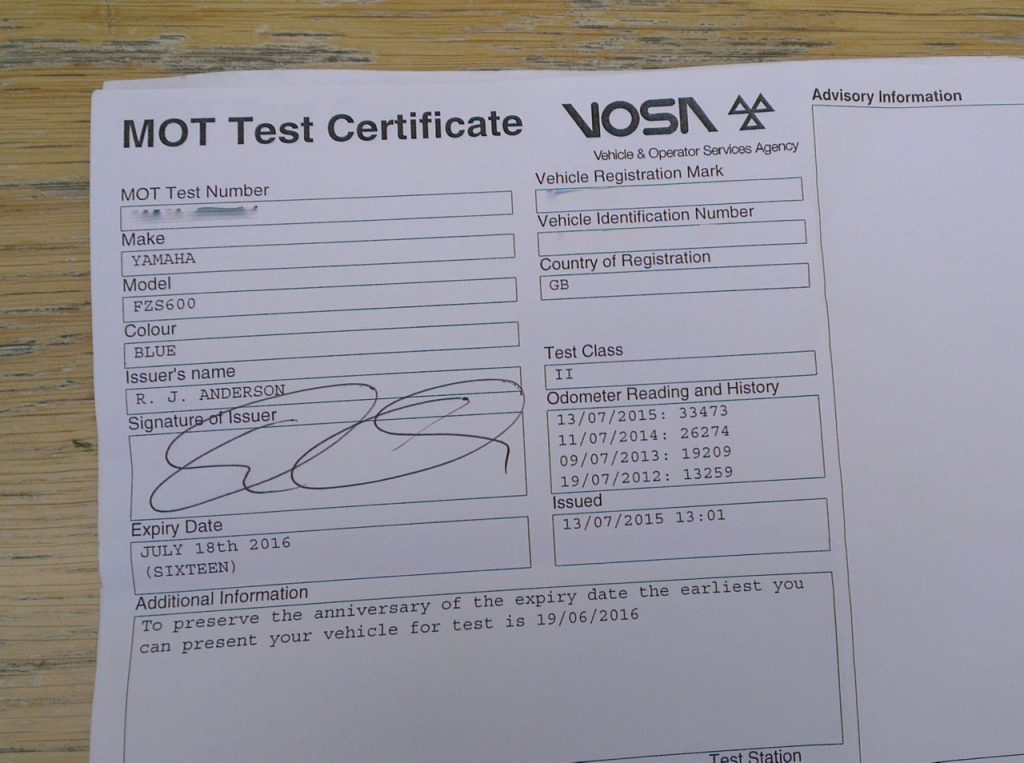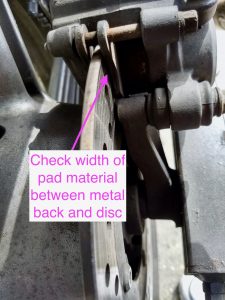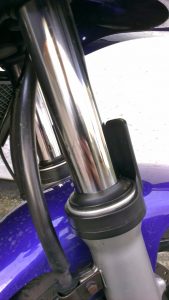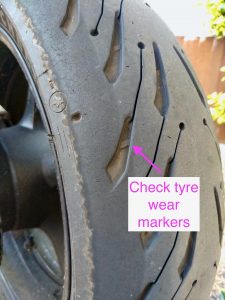If you have a motorcycle or scooter over three years old, you will need to submit it for an annual motorbike MOT test to ensure it is still safe and road legal. No one wants an MOT failure and the prospect of a large repair bill. However, a large majority of test failures are simple things that can easily be identified and fixed yourself before you take your bike to the garage.

Historic Motorcycle MOT Exemption
As of May 2018 historic motorcycles over 40 years old are exempt from MOT tests and vehicle tax. You will however need to apply for the ‘historic tax class’ – more details on the Gov.uk site. But note you can still be fined and get 3 points if your motorbike is not in a road worthy condition.
Covid19 Lockdown MOT Extension
Note there were MOT test date extensions brought in due to the Covid19 lockdown, don’t get caught out now this extension period is over:
- MOT’s expiring on or after 30th March and before 1st August, get a six-month extension
- MOT’s expiring on or after 1st August are due as normal
MOT Failure Statistics
Recently the Dept. for Transport (DfT) released MOT data for 2019, which provides for some interesting stats:
- 83% of motorcycles & scooters pass first time, compared to 67% of cars and light vehicles (up to 3,000 Kg)
- Across all vehicles types, 7% ‘Pass with Rectification’ – that is, after minor fixes at the test station within 1 hour
- 10% of motorcycles fail their MOT test, verses 25% of cars & light vehicles
Clearly, motorcycles are less likely to encounter an MOT test failure compared to other vehicles. In this article we will look at what the most common failure reasons are and if they could have been spotted before hand, thus compiling a motorcycle MOT checklist you can follow.
Motorcycle lamps and reflectors – 39%
The vast majority of failure reasons are lamps and reflectors at a whopping 39%. Issues that fall into this category will be:
- Light bulbs – easily checked beforehand and often easy to replace cheaply yourself.
- Broken brake light – often be as simple as blown bulbs, brake switches needing a blast of contact cleaner spray or minor adjustment of brake switch (common for rear brake pedal).
- White light leaking from broken coloured lenses – which you may be able to glue or replace easily yourself.
- Missing rear reflector – very common if you’ve fitted a third party tail tidy. Just get a little stick on red reflector for your number plate.
Posher LED lights that aren’t working could be a more complex electrical fault however.
Motorcycle Brakes – 17.5%

The next most common MOT failure reason is brakes, causing 17.5% or failures. Obviously brakes are pretty crucial, so it’s important they’re in good working order. You should at very least be aware of how to inspect your brake pads and discs for wear, even if you don’t service them yourself so you can book into a garage prior to your MOT.
- Check brake pad wear by inspecting the thickness of material between the disc and the metal backs of the pads. The minimum safe thickness varies between manufacturers, but is typically around 1.5 – 2 mm.
- Inspect brake fluid levels, if they’ve dropped you either have a leak or your brake pads a likely worn down.
- Check your brake discs. They should be smooth with no scouring or ripples on the surface, there shouldn’t be an excessive lip at the edges and a minimum thickness (checked with a vernier).
- MOT stations will test the effectiveness of your brakes using specialist test equipment, not something you can replicate at home. But you can just roll the bike forward and test the brakes can bring it to a prompt halt as a rough indication.
Motorcycle structure and attachments – 10%
This catch all category covers the bike frame, exhaust system, fuel system and transmission. DfT data doesn’t provide much breakdown, but it doesn’t take a genius to guess the common failures here.
- An overly loud or non road legal exhaust will certainly raise eye brows at the test station. Make sure your can is not marked ‘NOT FOR ROAD USE’, ‘TRACK USE ONLY’ or similar words.
- Check your chain is not worn or loose. Check sprockets are not worn down or teeth hooked.
- On older bikes check for any frame corrosion that could compromise the strength of the frame.
Motorcycle suspension – 9.5%

When it comes to motorcycle suspension, there’s very little quick and easy maintenance work anyone can do. However, you can easily identify one of the most common failures – leaking fork seals. Simply wipe the fork stanchions (the shiny chrome bits) down with a dry cloth, hold the front brake on and bounce the front up and down, then check if any oil has leaked up from the seals onto the stanchions. If so, then book yourself in for a fork service, parts are often cheap (£10-20 each) and expect around 2 hours labour.
Motorcycle tyres – 9%

I’m actually surprised tyres are not a more common failure reason, but only 9% of MOT failures are due to bad tyres. I guess most of us already pay a good deal of attention to our tyres, certainly makes sense since they’re so crucial in keeping us stuck to the road and being one of the most often replaced consumables on a motorbike. Nonetheless, inspect your tyres as part of your motorcycle MOT checklist:
- Check there is sufficient tread left, minimum of 1mm, for the middle 3/4 of the tyre width for entire circumference
- Most tyres have markers in the treads (see photo), indicating how low the surrounding rubber can wear down before they should be replaced
- Check there’s not excessive squaring off of tyres
- Check there’s no bulges, cracks or other damage
- Check air pressures are correct
Motorcycle steering – 5%
Just 5% of motorcycle MOT failures are due to steering faults, which will likely be down to the following reasons:
- Handlebars not rotating freely, for example hindered by badly routed cables and hoses, or they foul the tank or fairing. Check you can rotate them lock to lock unhindered.
- Worn head race bearings, that feel notchy when rotated or have excessive free play. Check the bars rotate smoothly when the front wheel is off the ground. Parts are generally cheap, but are a bit involved to fit, so have a word with your local garage.
- Wheels out of alignment, however beyond checking the rear wheel chain adjusters are on the same marker, this one is tricky to confirm without specialist equipment.
Identification of the vehicle – 5%
We’ve all heard about the seemingly ‘picky’ MOT tester who doesn’t like small number plates. Say what you will about aesthetics etc, if your bike is wearing a mini number plate or it’s tucked away under the tail and obscured, you’re just asking for an MOT failure (and plenty of Police attention too).
If you do have a legal size number plate, as part of your motorcycle MOT checklist do inspect it for any damage, delamination or discolouring.
Motorcycle audible warning (Horn) – 3.5%
A very easy one to check, your horn should be loud enough for other road users to hear and be a single continuous sound, multi-tone horns are a fail. There is no upper limit on horn loudness, so feel free to install a super loud air horn like the Denali SoundBomb to wake up the MOT tester!
Motorcycle MOT Checklist Conclusion
By following the above MOT checks you should be able to spot the most common failure reasons and be aware of motorcycle MOT requirements before you take you bike to the test station. Thus, hopefully you can then either resolve any issue yourself or get your bike booked into a garage before you fail an MOT. No point paying a garage over the odds to fix something simple like a light bulb when you can do it yourself for a couple of quid.
That said, the majority of the above motorcycle MOT checks are items you should be checking regularly as part of your POWDERS motorcycle pre-ride checks. If you’re doing this, then you shouldn’t have many MOT surprises anyway.
Source: Department of Transport – Anonymised MOT tests and results